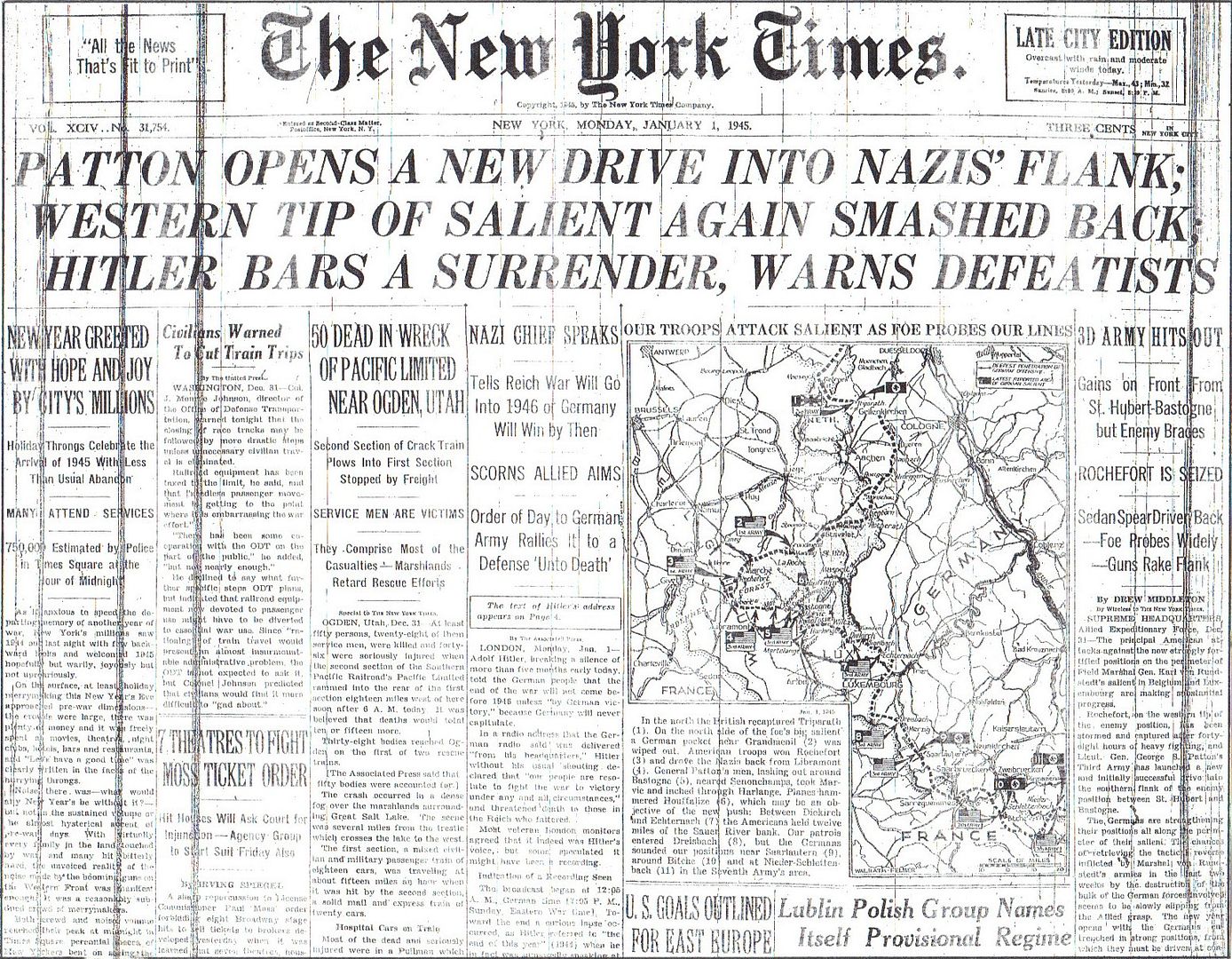
Posted on 01/01/2015 4:22:41 AM PST by Homer_J_Simpson

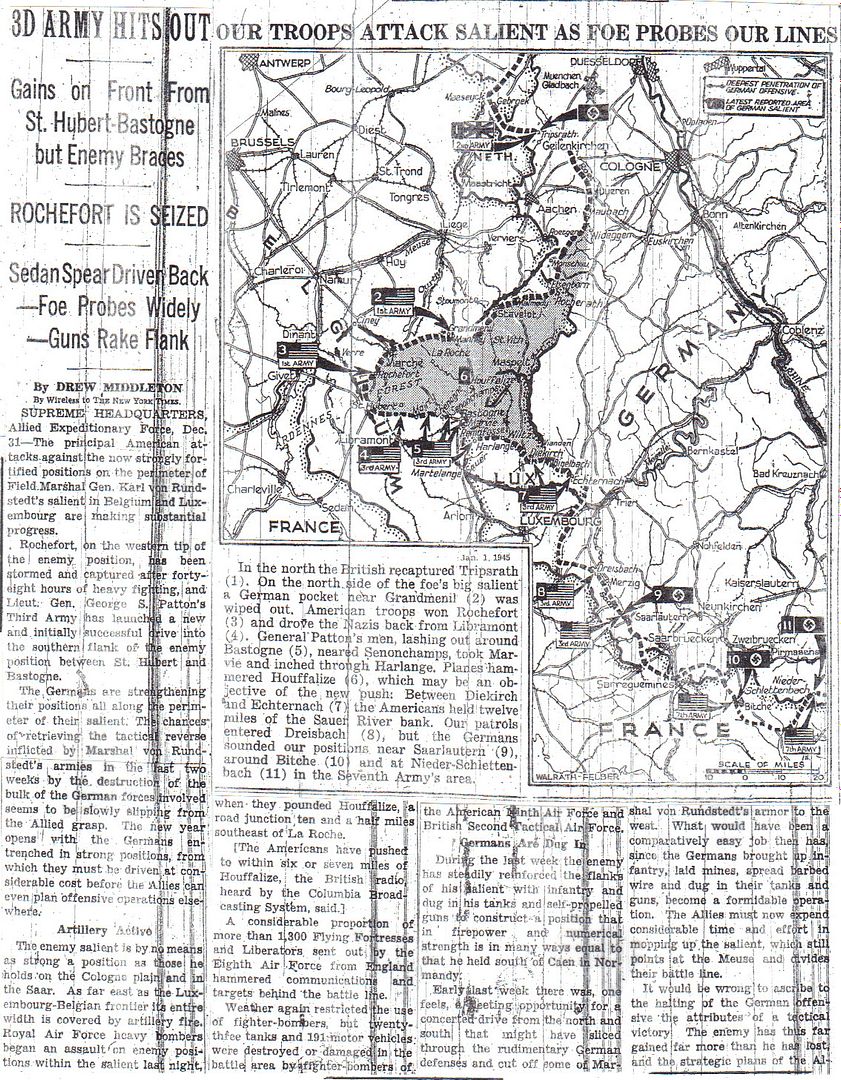

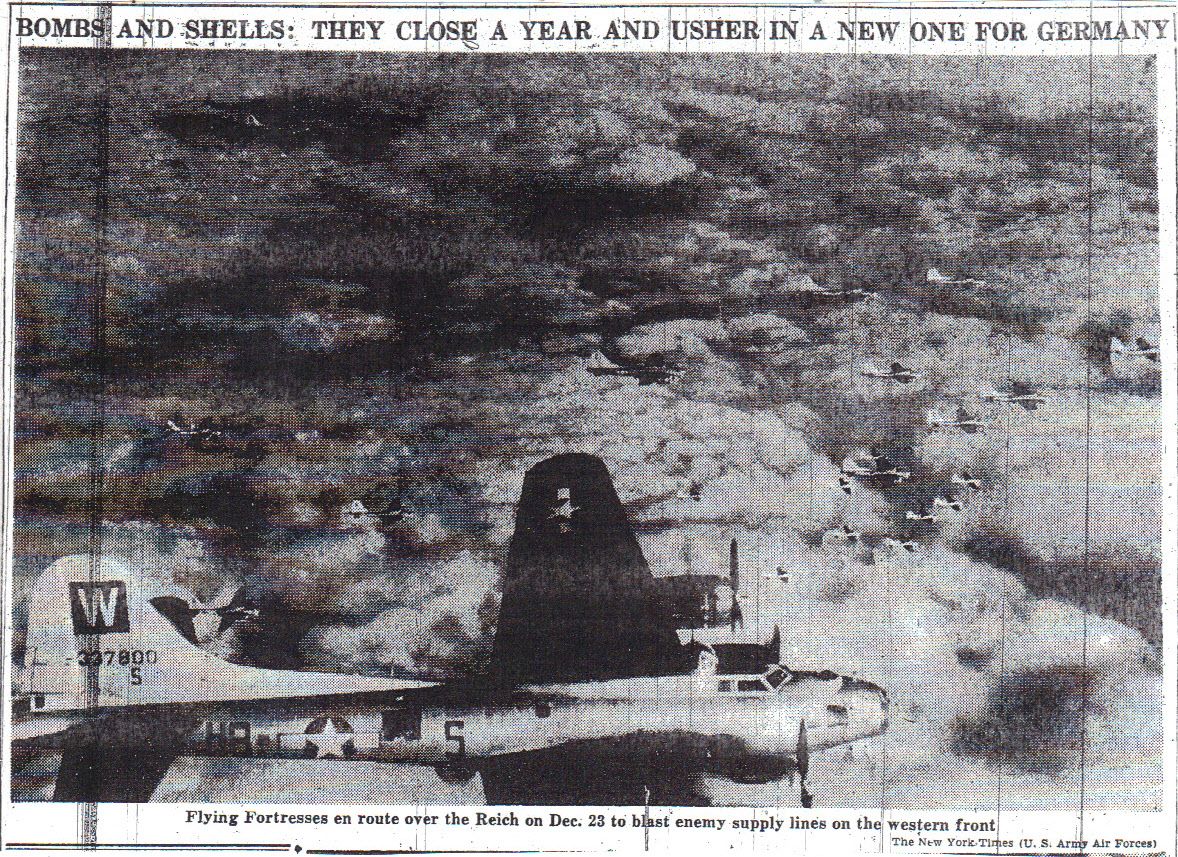
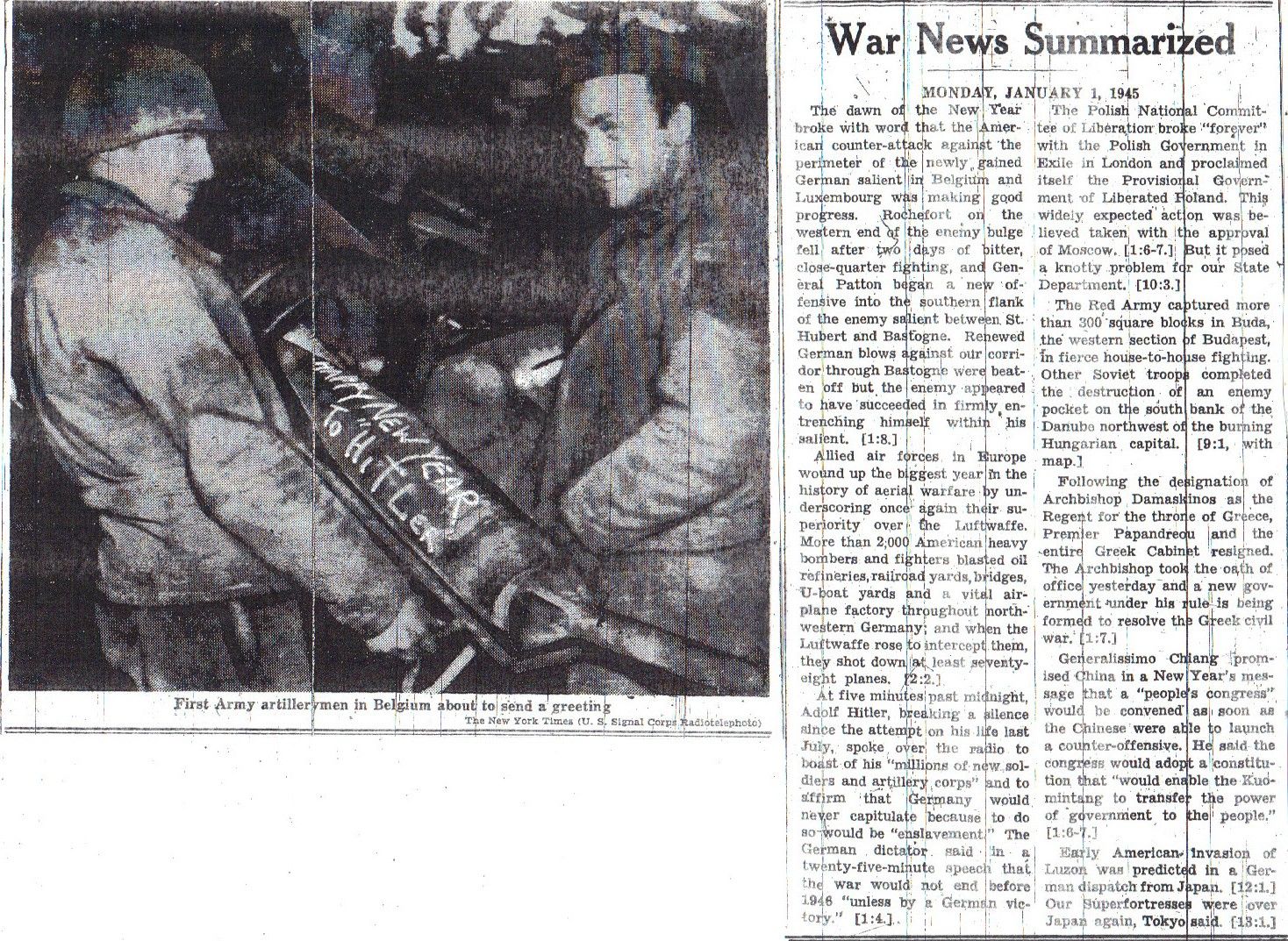

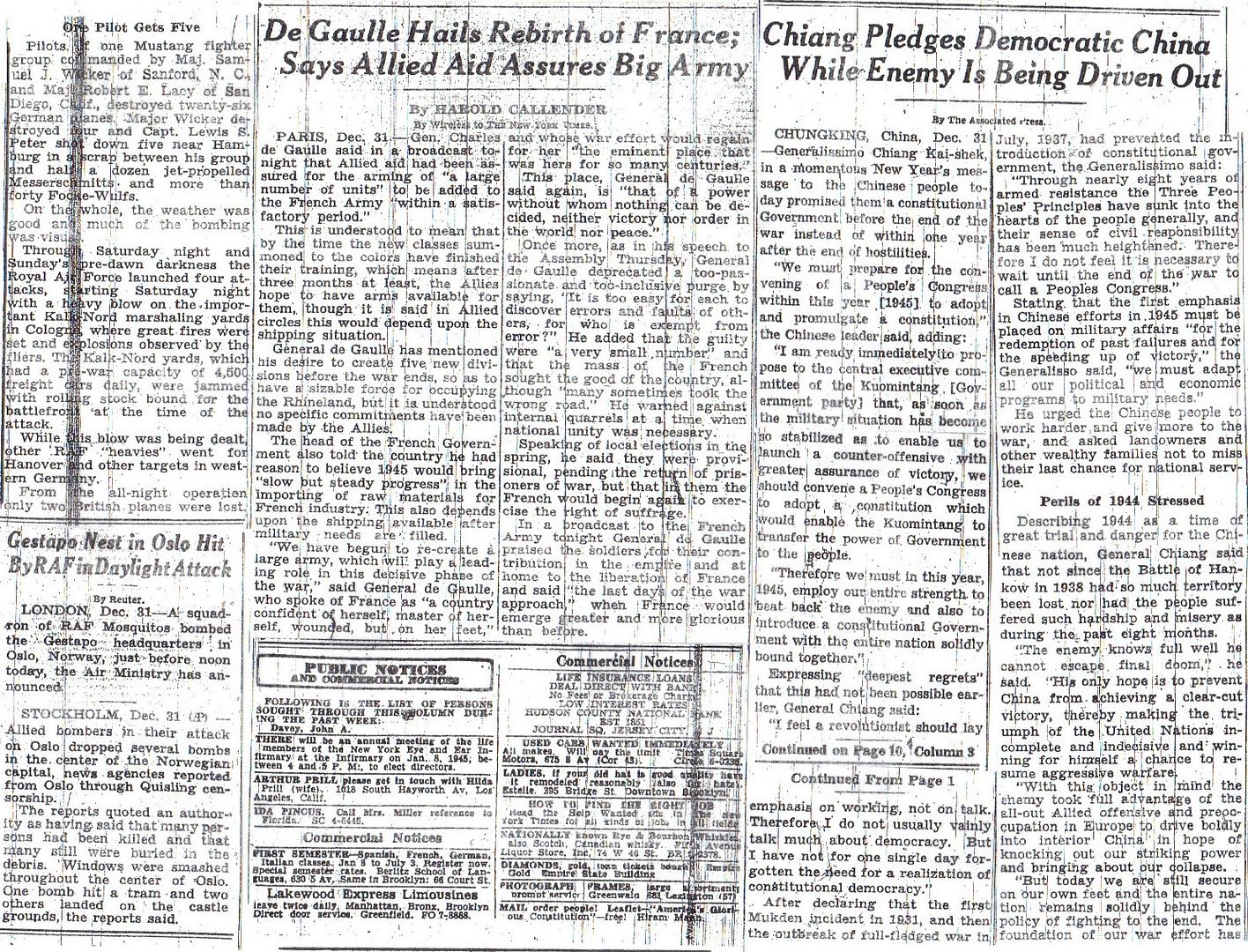
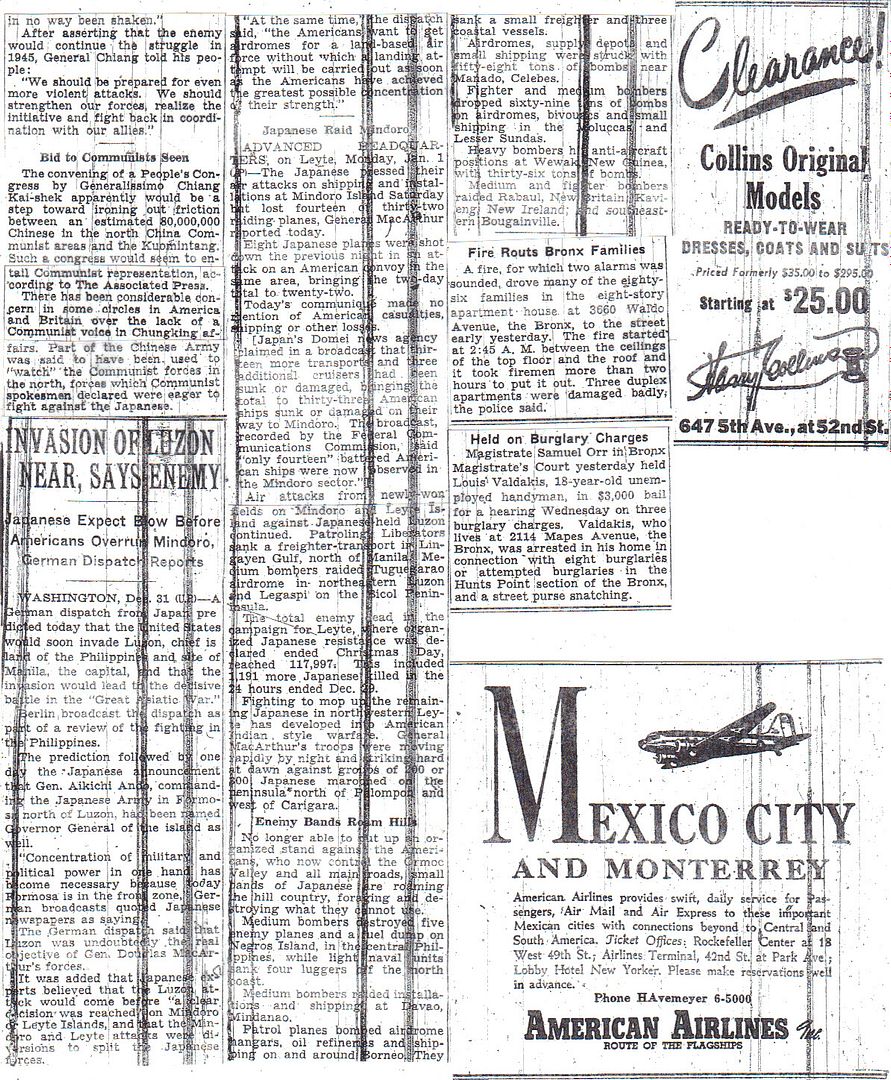
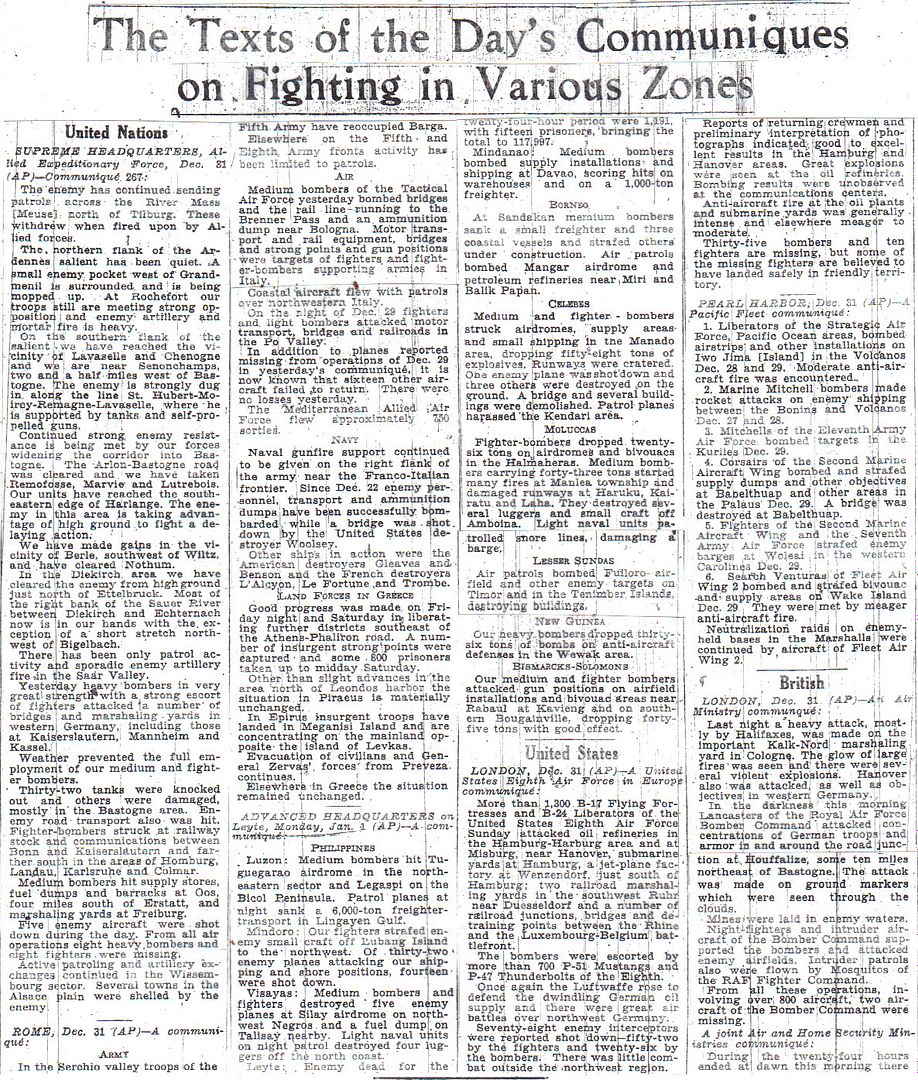
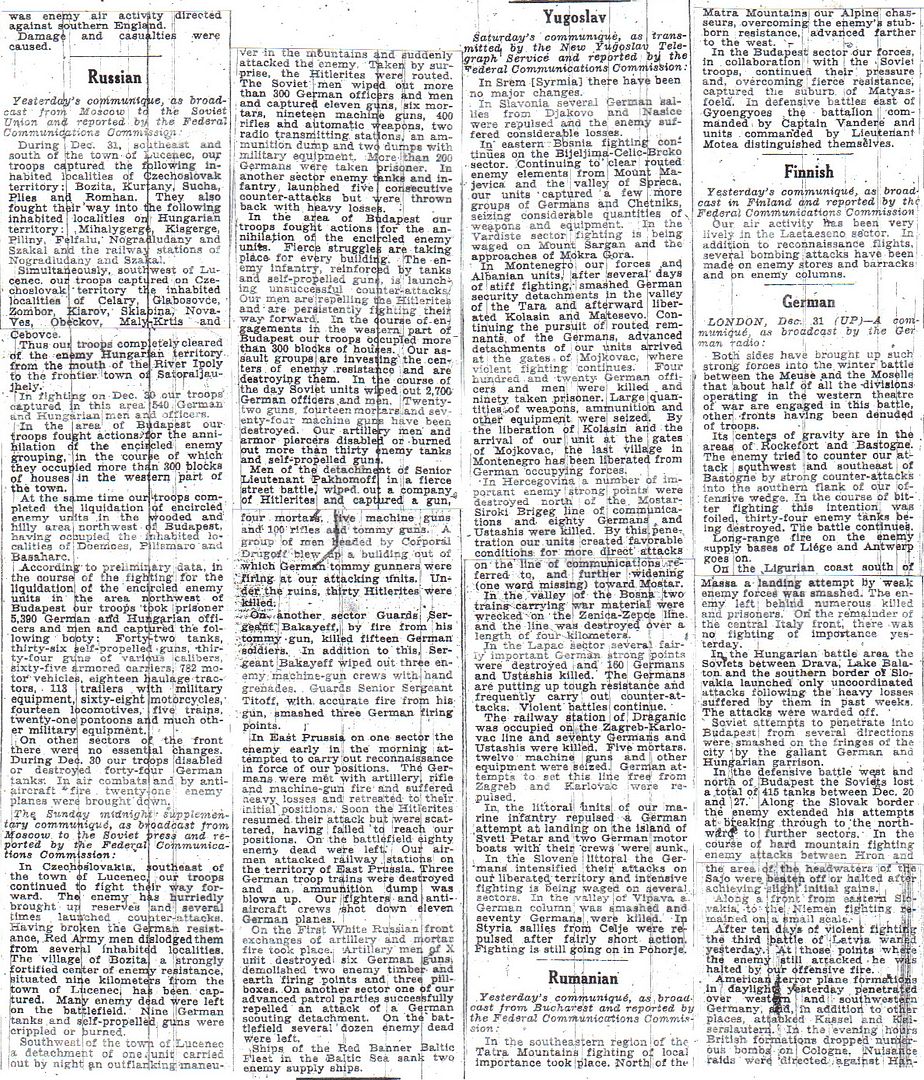

“On 1 January 1945, the 77TH Division was directed to relieve the 32D Division. Shortly thereafter, the 32D Division began to assemble in the Carigara-Pinamopoan area on Carigara Bay. There it received some well-earned rest, but it couldn't rest for long because it also had to start preparing for its next mission, the invasion of Luzon.
“The 32D Infantry Division suffered nearly 2,000 battle casualties during its 47 days of combat during the fight for Leyte, 450 of its soldiers had been killed, 1,491 soldiers wounded, and 8 soldiers were MIA.”
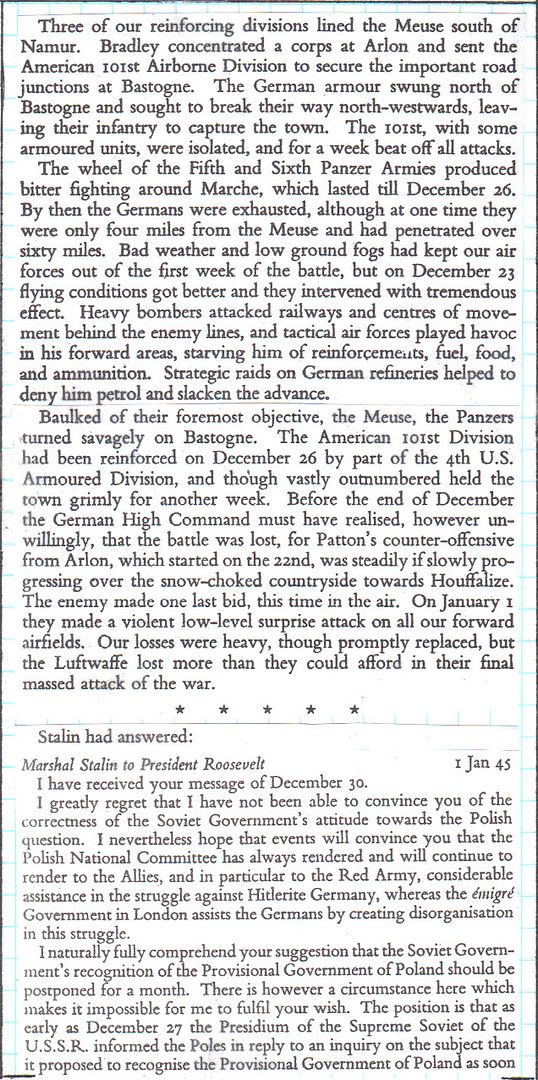
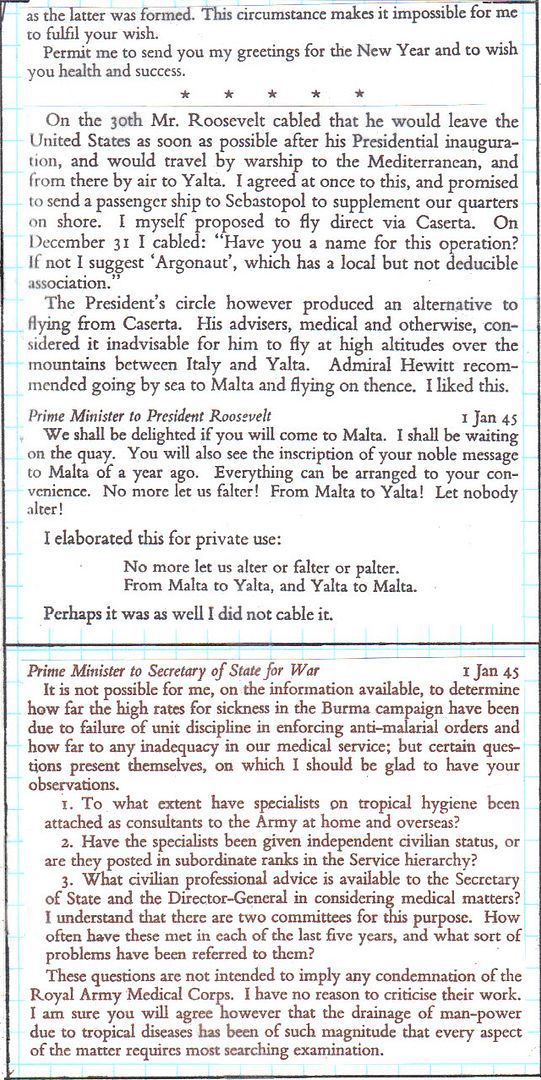
Winston S. Churchill, Triumph and Tragedy
3d Army Hits Out (Middleton, Johnston) – 2-3
Bombs and Shells: They Close a Year and Usher In a New One for Germany (photos) – 4-5
War News Summarized – 5
Nazi Chief Speaks – 6
3,500 Planes Rip 17 Reich Targets (Gruson) – 6-7
De Gaulle Hails Rebirth of France; Says Allied Aid Assures Big Army (Callender) – 7
Chiang Pledges Democratic China while Enemy is Being Driven Out – 7-8
Invasion of Luzon Near, Says Enemy – 8
The Texts of the Day’s Communiques on Fighting in Various Zones – 9-11
MacArthur’s Next Step (Baldwin) – 11
http://www.etherit.co.uk/month/0/01.htm
January 1st, 1945 (MONDAY)
UNITED KINGDOM: London: The quarrel over the future of Poland deepened yesterday when Winston Churchill made it plain that, until a full discussion has taken place between Britain, the USSR and the United States, he will not switch his allegiance from the London-based government in exile to the Russian-sponsored Lublin Committee. With the Russians in control of the liberated areas of Poland, however, there seems little that Mr. Churchill can do.
Repair ship HMS Deer Sound commissioned.
The USAAF”>USAAF Eighth Air Force flies Mission 775: five B-24 Liberators and three B-17 Flying Fortresses drop leaflet over Belgium and Germany during the night of 1st January without loss.
WESTERN EUROPE: Luftwaffe attacks many Allied airfields in Belgium, Holland and northern France. The Allied losses are large due to the surprise achieved, in spite of the lack of training for many German pilots. Meanwhile the Allied counterattack gathers force. List Member Roland P. Harper was there!
This was the Luftwaffe’s Operation BODENPLATTE intended to destroy Allied tactical fighter and bomber aircraft close to the front lines. The few remaining experienced German pilots led the flights that all too often were composed of new, partly trained airmen. This operation had been scheduled for late December but bad weather forced cancellations. The weather cleared on 1 January and 700 to 800 Luftwaffe aircraft, mostly Focke Wulf Fw 190s and Messerschmitt Bf 109s, hit RAF Second Tactical Air Force and USAAF Ninth Air Force airfields in Belgium, France and the Netherlands between 0800 and 1000 hours. In some cases, surprise was complete; in others Allied aircraft were airborne and engaged the enemy.
More often than not, the inexperience of the Luftwaffe pilots nullified the surprise of the attack.
452 Allied aircraft are destroyed or damaged beyond repair; Allied fighters shoot down 62 German aircraft and light anti-aircraft units shoot down 172 aircraft. Some of the Luftwaffe aircraft. Some of the Luftwaffe aircraft are shot down by their own anti-aircraft ground batteries who’s officers are not warned of the planned assault. The USAAF’s Ninth Air Force lost at least 30 aircraft on the ground while the RAF”> RAF’s Second Tactical Air Forces lost 162 aircraft plus 62 damaged.
FRANCE: The Commanding General U.S. 66th Infantry Division takes over the 94th Infantry Division’s mission of containing the Germans in the vicinity of Lorient and St Nazaire.
Alsace: In the 6th Army Group area, the Germans launch an offensive along a 50-mile front between Saarbrucken and Strasburg, designated Operation NORDWIND (North Wind), against the U.S. Seventh Army. The attack is carried out by General Hans von Obstfelder’s First Army with the aim of exploiting weaknesses in the US 6th Army Group caused by the withdrawal of forces to the Ardennes. Strasburg, which was only liberated last November, is the city most at risk. In the XV Corps area, a two-pronged German thrust forces the 106th Cavalry Group (Mechanized), 44th Infantry Division, and 100th Infantry Division to give ground. The 44th Infantry Division bears the brunt of German’s right flank drive, which penetrates positions northwest of Rimling. The 100th Infantry Division, caught between the two attack forces, withdraws its right flank, exposed by the withdrawal of Task Force Hudelson (VI Corps); German infiltrators are cleared from Rimling, on the left flank. Elements of Task Force Harris (63d Infantry Division) help check the Germans. Regimental Combat Team 145, 36th Infantry Division, moves up to plug the gap between the XV and VI Corps. In the VI Corps area, the Germans drive a salient into the left flank of the corps south of Bitche. Task Force Hudelson’s thin line is pushed back on the left to the Lemberg-Mouterhouse area. The 5th Infantry Division contains the Germans along the line Philippsbourg-Neuhoffen-Obersteinbach and mops up infiltrators in Dambach. Reinforcements from Task Force Herren (70th Infantry Division) and the 79th Infantry Division are rushed to the 45th Infantry Division, whose boundary is moved west. Combat Command B, 14th Armoured Division, moves to guard the Vosges exits. The 79th Infantry Division’s right flank is extended to include the Rhine sector from Schaffhouse to the Gambsheim area.
BELGIUM: A German A4 (V-2) rocket impacts in Antwerp, in Borgerhout, Groeningerplein. Forty five people are killed and 33 injured, and 21 houses destroyed.
The U.S. Third Army continues the Ardennes counteroffensive with the VIII and III Corps. In the VIII Corps area, the 87th Infantry Division takes Moircy and Jenneville. The 11th Armoured Division attacks with Combat Command A toward Hubermont, stopping east of Rechrival, and with Combat Command B, clears Chenogne and the woods to the north. Combat Command A, 9th Armoured Division, drives toward Senonchamps. The 101st Airborne Division, in the Bastogne area, gives fire support to the 11th Armoured Division on its left and the 6th Armoured Division (III Corps) on its right. The 4th Armoured Division holds a corridor into Bastogne and supports the 35th Infantry Division with fire. The 35th Infantry Division partially clears Lutrebois and reaches the crossroads southeast of Marvie, but makes no headway in the vicinity of Villers-la-Bonne-Eau and Harlange, Luxembourg. In the region east of Bastogne, the 6th Armoured Division takes Neffe, Bizery, and Mageret, but then loses Mageret.
LUXEMBOURG: In the U.S. Third Army’s III Corps area, the 17th Airborne Division relieves the 28th Infantry Division in the Neufchateau area. III Corps contains the German salient southeast of Bastogne.
GERMANY: Flt-Sgt George Thompson (b.1920), RAFVR, was severely burnt helping two gunners in their blazing Lancaster. He died of his injuries on 23 January. (Victoria Cross)
During the night of 1/2 January, RAF Bomber Command dispatches 152 Lancasters and five Mosquitos to carry out an accurate attack on the Gravenhorst section of the Mittelland Canal; 152 aircraft bomb the target. Half a mile (805 meters) of banks are pitted with bomb craters and some parts are breached. No aircraft are lost. In a second raid, 141 of 146 aircraft successfully attack the marshalling yard at Vohwinkel with the loss of one Lancaster. In a third raid, 105 Halifaxes, 18 Lancasters and 16 Mosquitos attempt to bomb the Minister Stein benzol plant at Dortmund; 117 bomb the target but the attack is scattered and the plant is not hit. No aircraft are lost. Mosquitos are also active: two “spoof” missions are flown with 26 aircraft bombing Hannover and 24 hitting Hanau; twelve attack 14 rail targets in western Germany with the loss of one aircraft and one each hit Bochum and Duisburg.
Stuka pilot Hans Ulrich Rudel is awarded the Knight’s Cross with Golden Oak leaves, Swords and Diamonds to the Iron Cross. This is the highest single grade of the Knight’s Cross of the Iron Cross and was awarded only once during WWII. It was awarded to Hans Ulrich Rudel (Jan 1, 1945) in honour of his unrivalled heroism as a Luftwaffe Stuka pilot. Rudel was responsible for the destruction of 530 Soviet tanks, enough tanks for five complete Soviet Tank Corps! He also destroyed 150 anti-aircraft and anti-tank positions, 800 motor vehicles, the Soviet Battleship Marat, a Soviet Cruiser, a Soviet Destroyer, 70 Soviet landing craft, and numerous bridges and bunkers. He also heavily damaged another Soviet Battleship, the October Revolution. Rudel flew 2,530 combat missions, claimed 11 air victories in his Stuka, and was shot down 32 times. During the War, Stalin placed a 100,000 Rouble bounty on him for his capture payable dead or alive.
The USAAF Eighth Air Force flies Mission 774: 845 bombers and 725 fighters are dispatched to hit oil installations and rail bridges and junctions in western Germany visually and by PFF; they claim 23-1-3 Luftwaffe aircraft including a jet fighter; eight bombers and two fighters are lost. The targets are (numbers in parenthesis indicate number of aircraft bombing and number lost, e.g., 97-1):
- Bridge: Andernach (25-0).
- Marshalling yards: Rothenditmold at Kassel (309-2); Gottengen (30-0); Dillenburg (15-0); Hadamar, Limburg, Mosel at Koblenz and Wetzlar (12-0).
- Oil refineries: Dollbergen (54-0) and Rothensee at Magdeburg (11-5).
- Oil storage: Ehmen (24-0).
- Rail bridges: Lutzel at Koblenz (57-0); Neuweid (55-0); Guls at Koblenz (30-1); Kronprinz Wilhelm at Engers (9-0) and Ludendorff at Remagen (6-0).
Fifty four other aircraft bomb targets of opportunity.
The USAAF Ninth Air Force dispatches 190 A-20 Havocs, A-26 Invaders and B-26 Marauders to hit rail bridges, communications centres, a road junction, a command post, and headquarters, all in Belgium and Germany. Fighters escort 9th Bombardment Division and Eighth Air Force bombers, fly patrols, sweeps, and armed reconnaissance (claiming 39 air victories and numerous ground targets destroyed) and support the U.S. III, VII, and XII Corps between Saint-Hubert, Belgium and the Mosel River, Germany.
U-1199 sailed on her second and final patrol.
EASTERN FRONT: Some of the last school and training boats left the bases in the eastern Baltic Sea, such as Pillau and Königsberg, due to the approaching Red Army.
U-310 suffered damage when she struck the seabed in the Arctic Sea.
NETHERLANDS: Eighteen Kriegsmarine Seehund midget submarines leave the naval base at Ijmuiden, west of Amsterdam. It is their first sortie. One is blown up by a mine and later only two will return. High winds and rough seas are thought to account for most of those lost. The crews had not been trained for bad weather. (William L. Howard)
HUNGARY: Fighting continues within and around Budapest, where the Soviets are slowly eliminating the besieged German garrison.
POLAND: The Soviets set up a Soviet-dominated government (the Lublin Committee) meeting with little effective resistance.
ITALY: USAAF Twelfth Air Force medium bombers attack bridges at Palazzuolo sull’Oglio, Parma, and Calcinato (the latter two targets are missed) and an ammunition dump at Parma. Fighter-bombers support ground forces south of Bologna, hit communications and numerous targets of opportunity to the north and completely destroy a fuel dump at Parma. During the night of 1/2 January, A-20 Havocs continue intruder missions over the Po Valley.
JAPAN: The New Year is beginning with US air attacks bringing the war ever closer to the Japanese homeland. As the outer ramparts of Japan’s Asiatic empire crumble in the face of the Allied advances, Japan is losing all control of the air and sea. Desperate for a reprieve from the slide to defeat, the Japanese are now resorting to bizarre methods of warfare, including kamikaze air attacks and suicide submarines.
The Japanese have strengthened the homeland by withdrawing aircraft and anti-aircraft weapons from outlying regions. Whole Japanese armies in the South-west Pacific have been abandoned by Japan after Allied forces bypassed them and left them to “wither on the vine” under Allied air attack and naval blockade.
In South-east Asia air mastery over the Japanese has long been established, and the Allied air forces maintain relentless pressure on the retreating enemy in Burma. The US Fourteenth Army Air Force is active in China, Indochina and Burma. In the East China Sea, fast carriers of the US Third Fleet are currently hammering enemy airfields on Formosa, the Pescadores, the Ryukus and Luzon to frustrate the kamikaze planes waiting to pounce on MacArthur’s invasion force approaching Lingayen Gulf.
The government in Tokyo was deeply shocked when the Americans invaded the Marianas last June, thus threatening a B-29 bombing campaign from only 1,500 miles away. That threat became reality when the Americans based two wings of B-29s there. On 24 November, 111 B-29s took off to subject Tokyo to its first mass air raid. More will follow.
VOLCANO ISLANDS: Nineteen USAAF Seventh Air Force B-24 Liberators from Saipan bomb Iwo Jima; nine more, during snooper missions on the night of 1/2 January, hit the island at varying intervals.
CHINA: Three USAAF”> USAAF Fourteenth Air Force B-24 Liberators bomb Ft Bayard and 40 P-51 Mustangs and P-40s attack railroad targets, warehouses, industrial works, and gun positions from Yoyang to Puchi. Eight P-51s hit Suchow Airfield, claiming 25 aircraft destroyed while 47 other P-40s and P-51s on armed reconnaissance hit troops, horses, town areas, and rail and road traffic at several locations especially at Liuchenghsien and between Siaokan and Hsuchang.
BURMA: Seventy one USAAF Tenth Air Force P-47 Thunderbolts and P-38 Lightnings attack villages, general supply areas, fuel dumps, tanks and other vehicles, and troop concentrations at several locations including Man Hio, Bahe, Mongmit, Hatka, Namhpakka, Loi-hseng, Mong Yaw and in the Hsenwi area, four others hit targets of opportunity along the Irrawaddy River from Tanaung to Kyungyi. Four B-25 Mitchells harass communications lines during the night of 1/2 January.
EAST INDIES: On Halmahera Island, USAAF Far East Air Forces B-24 Liberators along with B-25 Mitchells hit the Djailolo, Wasile Bay bivouac areas, and Miti ammunition dump. B-25s also bomb airfields on Ceram Island. Airfields, shipyards, and other targets in the Borneo, Celebes and Lesser Sunda Islands also sustain light raids, by fighters and bombers, which also fly armed reconnaissance. Twelve RAAF (P-40) Kittyhawks bomb Galela No. 2 Airstrip on the west side of the Wasile Bay.
COMMONWEALTH OF THE PHILIPPINES: Operations to deceive the Japanese about Allied intentions against Luzon begin with limited action on Mindoro to clear the north-eastern part of the island. Subsequent deceptive measures conducted on southern Luzon are on a much smaller scale than anticipated and have little effect on the main operation.
On Mindoro Island, control of the Western Visayan Task Force passes from the U.S. Sixth to the U.S. Eighth Army. Company I, 21st Infantry Regiment, 24th Infantry Division, moving by water from San Jose, lands on the east coast at Bongabong without incident and marches northward toward Pinamalayan.
On Leyte Island, the U.S. Eighth Army mops up, a tedious business that lasts until 8 May 1945. The 77th Infantry Division of the XXIV Corps is ordered to relieve the 1st Cavalry and 32d and 24th Infantry Divisions of X Corps.
USAAF”>USAAF Far East Air Forces B-25 Mitchells and fighter-bombers make low level attacks on Negros Island airfields; B-24 Liberators, with P-38 Lightning cover, bomb Clark Field on Luzon and others bomb the Sasa area on Mindanao Island. B-25 Mitchells bomb barracks at Laoag on Luzon. Fighter-bombers are active against targets in the Manila area on Luzon and also hit Silay on Negros.
CAROLINE ISLANDS: Elements of the 321st Infantry Regiment, U.S. 81st Infantry Division, land on Fais Island., southeast of Ulithi Atoll, and begin a search of the island.
TERRITORY OF ALASKA: A Japanese Fu Go paper, including envelope, rigging, apparatus and two sand bags, is recovered 15 miles (24 kilometres) north of Marshall. It is believed that the balloon landed on 23 December 1944. Marshall is located about 210 miles (338 kilometres) southeast of Nome.
CANADA: Several fragments of a Japanese Fu Go balloon are recovered near Stony Rapids, Saskatchewan. Stony Rapids is located about 490 miles (789 kilometres) north of Saskatoon, Saskatchewan. It is unknown when this balloon landed.
U.S.A.:
The French government officially joins in full partnership in the United Nations, three years after the French Committee on National Liberation agreed to participate in the international organization.
Top songs on the pop music charts are: “Don’t Fence Me In” by Bing Crosby and The Andrews Sisters; “There Goes that Song Again” by Russ Morgan; “I’m Making Believe” by Ella Fitzgerald and The Ink Spots; and “I’m Wastin’ My Tears on You” by Tex Ritter.
Destroyer USS Leary launched.
Submarines USS Requin and Stickleback launched.
Printers (or archivists) hung-over?
I'm reminded of the New Year's toast offered by Colonel Potter in 1952: "Here's to the new year. Maybe it be a damn sight better than the old one, and may we all be home before it's over."
“First Army artillerymen in Belgium about to send a greeting.” — LOL!
Bottom of Page 6: “Chaplin, Hurt, Is In Hospital”
Charles Chaplin is in Cedars of Lebanon Hospital with ankle cuts which, police said, he received when he kicked in a glass door of his home last night after he had misplaced his keys. Dr. N.E. Gourson (?) reported that some ankle muscles were cut and that the film comedian might be in the hospital for three days and could not use his left foot for two weeks. A recess in the paternity suit by Joan Barry against Mr. Chaplin ends Tuesday.
1. Does the Times give its writers prizes for writing stories with the fewest punctuation marks? “Two paragraphs - and you get three periods, one comma, and one semicolon!”
2. Why were the police involved, and did they “act stupidly”?
“50 Dead in Wreck of Pacific Limited Near Ogden, Utah.”
Service men are victims.
91 year old vet couple days ago here reveals for the first time that he was working on ‘Patton`s secret weapon” project used for the first time in the Battle of Bastogne- The Proximity Fuse for artillery shells... even tho he still refuses to tell us to this day that it was the proximity fuse project, but just “Patton`s secret weapon”
91 year old vet couple days ago here reveals for the first time that he was working on ‘Patton`s secret weapon” project used for the first time in the Battle of Bastogne- The Proximity Fuse for artillery shells... even tho he still refuses to tell us to this day that it was the proximity fuse project, but just “Patton`s secret weapon”
From Atkinson’s The Guns at Last Light
The attack indeed fell that night, the last substantial German offensive of the war in western Europe. Hitler had given another Adlerhorst pep talk to commanders in Army Group G, conceding failure in the Ardennes, but offering another chance to thrash the Americans in Operation NORDWIND, North Wind. A lunge by eight divisions southwest down the Vosges axis would recapture the Saverne Gap and link up with Nineteenth Army Group troops occupying the Colmar pocket; in addition, the attack would force Patton to withdraw from Bastogne to parry this new threat. French troops in Alsace were weak and disorganized, the Fruhrer promised, and the U.S. Seventh Army was overextended along a 126 mile perimeter.
The Americans were also alert and entrenched. Ultra intercepts provided no specific enemy attack order, but ample intelligence revealed the German order of battle and unit boundaries below Saarbrucken. Patch had little doubt that the main attack would come against the Seventh Army left, west of the Haardt Mountains, with a complimentary attack to the east between the mountains and the Rhine.
“German offensive began on Seventh Army front about 0030 hours,” Patch’s chief wrote in a diary entry on Monday, January 1. “Krauts were howling drunk. Murdered them.” Shrieking Waffen-SS troops, silhouetted by moonlight that glistened off snowfields near the Sarre River, hardly dented the American left wing. A single .30-caliber water-cooled machine gun, slewing left and right with long, chattering bursts, was credited with slaying more than one hundred attackers. Volksgrenadier corpses piled up in a kill sack soon dubed, “Morgue Valley.” “Gained only insignificant ground,” the Army Group G war diary recorded; then by nightfall on Tuesday: “The attack lost its momentum.”
The most flamboyant German sally occurred on New Year’s Day, an attack by nine hundred Luftwakke planes flying treetop altitude across the Western Front. Operation BODENPLATTE, Baseplate, also known as the “Hangover Raid,” included pilots said to be wearing dress uniforms with patent-leather shoes and white gloves after celebrating the arrival of 1945. The raiders caught seventeen Allied airfields by surprise, destroying 150 parked planes and damaging more than 100 others. Montgomery’s personal aircraft was among those wrecked. But German losses approached 300 planes, some shot down by their own antiaircraft gunners who, for reasons of secrecy, had not been informed of BODENPLATTE. Worse still was the loss of 237 German pilots, including veteran airmen, instructors, and commanders. “We sacrificed our last substance,” one Luftwaffe office said.
Even as NORWIND collapsed on the German right, an ancillary New Year’s attack ten miles to the east spilled from old Mignot Line bunkers to gain traction through corrugated terrain below Bitche. Bypassing American strongpoints in the Low Vosges, the 6th SS Mountain Division bent the Seventh Army line sufficiently to alarm SHAEF and terrify Strasbourg, thirty miles southeast. Propaganda broadcasts from Radio Stuggart reported German shock troops assembling to seize the city, with reprisals certain to fall on Alsatians who had helped the Allies. Rumors of Seventh Army detachments packing to leave along the Rhine “spread like a powder fuze and caused a general panic,” according to a French lieutenant.
Lowered tricolors and the sight of official sedans being gasses up added to the dread. Journalists reported that roads west were clogged with “women pushing baby carriages [and] wagons piled high with furniture, as “Strasbourg steeled itself for yet another reversal of fortune. One soldier spied inverted dinner plates laid across a road in the thin hope that they sufficiently resembled an antitank mines to delay, at least briefly, the Hun’s return.
Happy New Year, Homer!
I hope Charlie Chaplin’s ankle heals quickly and that he finds his house keys!
Nimitz Gray book:
IWO JIMA was hit on the 31st and 1st by a number of B-24s. On the 312st 10 B-2r’s snoop bombed the airfields by radar every 45 minutes. Again on the 1 of January 19 B-24’s bombed both airfields with 36 tons.
History has told us that the island was heavily bombed for 2-3 months prior to invasion. The insinuation is everything was done to prepare for invasion but there is indication here that the bombing was NOT to prepare for invasion but was to protect the b29s and it was not effective?
Hind sight is 20/20 and I am not being critical as I was not there but it is beginning to look to me like the only preparation for invasion was the very few days of artillery before the invasion? I am not saying this was intentional but was the result.
The marines claims the pre invasion was not enough and they might be right?
P-38J Lightning aircraft with the 'droop snoop' conversion in practice bombing, probably in the United States, 1943-1945
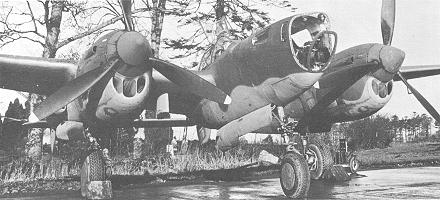
The nickname "Droop Snoop" was given to Lightnings which had bombardier-type noses. These planes carried Norden Bomb sights and guided fleets of bomb laden P-38's to their targets. P-38L's were converted to this role.
Snooper bomber were night bombers sent over to harass the Japanese. Most likely they were radar equipped.
More here...http://ww2b24snoopers.blogspot.com/
Regards
alfa6 ;>}
Whoops. Looks like I lost the images. But the text tells the story.
Disclaimer: Opinions posted on Free Republic are those of the individual posters and do not necessarily represent the opinion of Free Republic or its management. All materials posted herein are protected by copyright law and the exemption for fair use of copyrighted works.